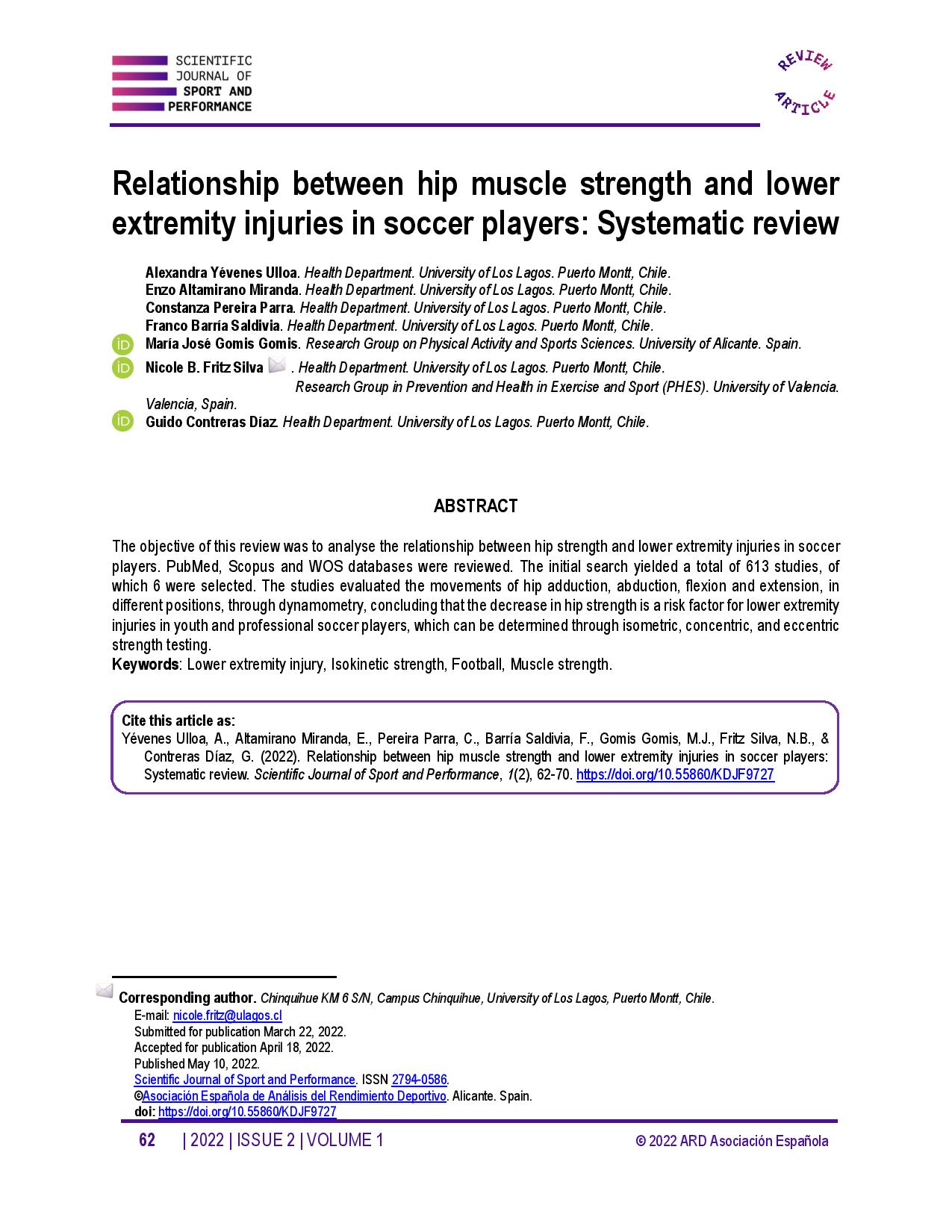Relationship between hip muscle strength and lower extremity injuries in soccer players Systematic review
Main Article Content
Abstract
The objective of this review was to analyse the relationship between hip strength and lower extremity injuries in soccer players. PubMed, Scopus and WOS databases were reviewed. The initial search yielded a total of 613 studies, of which 6 were selected. The studies evaluated the movements of hip adduction, abduction, flexion and extension, in different positions, through dynamometry, concluding that the decrease in hip strength is a risk factor for lower extremity injuries in youth and professional soccer players, which can be determined through isometric, concentric, and eccentric strength testing.
Article Details

This work is licensed under a Creative Commons Attribution-NonCommercial-ShareAlike 4.0 International License.
References
Askling, C. M., Tengvar, M., Saartok, T., & Thorstensson, A. (2007). Acute first-time hamstring strains during high-speed running: a longitudinal study including clinical and magnetic resonance imaging findings: A longitudinal study including clinical and magnetic resonance imaging findings. Am J Sports Med, 35(2), 197–206. https://doi.org/10.1177/0363546506294679 DOI: https://doi.org/10.1177/0363546506294679
De Ridder, R., Witvrouw, E., Dolphens, M., Roosen, P., & Van Ginckel, A. (2017). Hip strength as an intrinsic risk factor for lateral ankle sprains in youth soccer players: A 3-season prospective study. Am J Sports Med, 45(2), 410–416. https://doi.org/10.1177/0363546516672650 DOI: https://doi.org/10.1177/0363546516672650
Deane, R. S., Chow, J. W., Tillman, M. D., & Fournier, K. A. (2005). Effects of hip flexor training on sprint, shuttle run, and vertical jump performance. J Strength Cond Res, 19(3), 615–621. https://doi.org/10.1519/14974.1 DOI: https://doi.org/10.1519/00124278-200508000-00022
Karatrantou, K., Gerodimos, V., Katsareli, E., Manouras, N., Ioakimidis, P., & Famisis, K. (2019). Strength profile of hip abductor and adductor muscles in youth elite soccer players. J Hum Kinet, 66(1), 31–41. https://doi.org/10.2478/hukin-2018-0069 DOI: https://doi.org/10.2478/hukin-2018-0069
Lavoie-Gagne, O., Mehta, N., Patel, S., Cohn, M. R., Forlenza, E., Nwachukwu, B. U., & Forsythe, B. (2021). Adductor muscle injuries in UEFA soccer athletes: A matched-cohort analysis of injury rate, return to play, and player performance from 2000 to 2015. Orthop J Sports Med, 9(9), 23259671211023096. https://doi.org/10.1177/23259671211023098 DOI: https://doi.org/10.1177/23259671211023098
López-Valenciano, A., Ruiz-Pérez, I., Garcia-Gómez, A., Vera-Garcia, F. J., De Ste Croix, M., Myer, G. D., & Ayala, F. (2020). Epidemiology of injuries in professional football: a systematic review and meta-analysis. Br J Sports Med, 54(12), 711–718. https://doi.org/10.1136/bjsports-2018-099577 DOI: https://doi.org/10.1136/bjsports-2018-099577
Maher, C. G., Sherrington, C., Herbert, R. D., Moseley, A. M., & Elkins, M. (2003). Reliability of the PEDro scale for rating quality of randomized controlled trials. Physical Therapy, 83(8), 713–721. https://doi.org/10.1093/ptj/83.8.713 DOI: https://doi.org/10.1093/ptj/83.8.713
Markovic, G., Šarabon, N., Pausic, J., & Hadžić, V. (2020). Adductor muscles strength and strength asymmetry as risk factors for groin injuries among professional soccer players: A prospective study. Int J Environ Res, 17(14), 4946. https://doi.org/10.3390/ijerph17144946 DOI: https://doi.org/10.3390/ijerph17144946
Moreno-Pérez, V., Travassos, B., Calado, A., Gonzalo-Skok, O., Del Coso, J., & Mendez-Villanueva, A. (2019). Adductor squeeze test and groin injuries in elite football players: A prospective study. Phys Ther Sport, 37, 54–59. https://doi.org/10.1016/j.ptsp.2019.03.001 DOI: https://doi.org/10.1016/j.ptsp.2019.03.001
Mosler, A. B., Weir, A., Serner, A., Agricola, R., Eirale, C., Farooq, A., Bakken, A., Thorborg, K., Whiteley, R. J., Hölmich, P., Bahr, R., & Crossley, K. M. (2018). Musculoskeletal screening tests and bony hip morphology cannot identify male professional soccer players at risk of groin injuries: A 2-year prospective cohort study. Am J Sports Med, 46(6), 1294–1305. https://doi.org/10.1177/0363546518763373 DOI: https://doi.org/10.1177/0363546518763373
Namazi, P., Zarei, M., Hovanloo, F., & Abbasi, H. (2019). The association between the isokinetic muscle strength and lower extremity injuries in young male football players. Phys Ther Sport, 39, 76–81. https://doi.org/10.1016/j.ptsp.2019.06.013 DOI: https://doi.org/10.1016/j.ptsp.2019.06.013
Neto, W. K., Vieira, T. L., & Gama, E. F. (2019). Barbell Hip Thrust, Muscular Activation and Performance: A Systematic Review. J Sports Sci Med, 18(2), 198–206.
Pfirrmann, D., Herbst, M., Ingelfinger, P., Simon, P., & Tug, S. (2016). Analysis of injury incidences in male professional adult and elite youth soccer players: A systematic review. J Athl Train, 51(5), 410–424. https://doi.org/10.4085/1062-6050-51.6.03 DOI: https://doi.org/10.4085/1062-6050-51.6.03
Page, M. J., McKenzie, J. E., Bossuyt, P. M., Boutron, I., Hoffmann, T. C., Mulrow, C. D., Shamseer, L., Tetzlaff, J. M., Akl, E. A., Brennan, S. E., Chou, R., Glanville, J., Grimshaw, J. M., Hróbjartsson, A., Lalu, M. M., Li, T., Loder, E. W., Mayo-Wilson, E., McDonald, S., … Moher, D. (2021). The PRISMA 2020 statement: an updated guideline for reporting systematic reviews. BMJ (Clinical Research Ed.), 372 (71). https://doi.org/10.1136/bmj.n71 DOI: https://doi.org/10.1136/bmj.n71
Powers, C. M., Ghoddosi, N., Straub, R. K., & Khayambashi, K. (2017). Hip strength as a predictor of ankle sprains in male soccer players: A prospective study. J Athl Train, 52(11), 1048–1055. https://doi.org/10.4085/1062-6050-52.11.18 DOI: https://doi.org/10.4085/1062-6050-52.11.18
Ronnestad, B. R., Kvamme, N. H., Sunde, A., & Raastad, T. (2008). Short-term effects of strength and plyometric training on sprint and jump performance in professional soccer players. J Strength Cond Res, 22(3), 773–780. https://doi.org/10.1519/JSC.0b013e31816a5e86 DOI: https://doi.org/10.1519/JSC.0b013e31816a5e86
Serin, E. (2017). Relationship between the hip anatomy and sporting performance. European Journal of Physical Education and Sport Science, 3(10). https://doi.org/10.5281/zenodo.1043342
Thorborg, K., Couppé, C., Petersen, J., Magnusson, S. P., & Hölmich, P. (2011). Eccentric hip adduction and abduction strength in elite soccer players and matched controls: a cross-sectional study. Br J Sports Med, 45(1), 10–13. https://doi.org/10.1136/bjsm.2009.061762 DOI: https://doi.org/10.1136/bjsm.2009.061762
Turner, A. N., & Stewart, P. F. (2014). Strength and conditioning for soccer players. J Strength Cond Res, 36(4), 1–13. https://doi.org/10.1519/ssc.0000000000000054 DOI: https://doi.org/10.1519/SSC.0000000000000054
Wollin, M., Pizzari, T., Spagnolo, K., Welvaert, M., & Thorborg, K. (2018). The effects of football match congestion in an international tournament on hip adductor squeeze strength and pain in elite youth players. J Sports Sci, 36(10), 1167–1172. https://doi.org/10.1080/02640414.2017.1363452 DOI: https://doi.org/10.1080/02640414.2017.1363452




